On the inside cover of the Moving Beyond the Page catalog,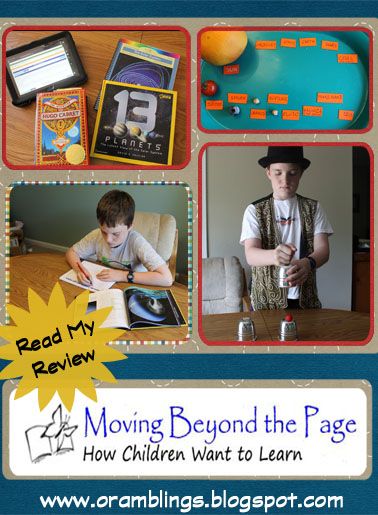 in bold lettering, it says “It is essential that children become thinkers and problem solvers, not just memorizers of facts.” Since I agree so heartily with that statement, I was pleased to be selected to review two of their unit studies. Although Moving Beyond the Page is marketed a full-year, unit study based curriculum covering literature, science, and social studies you may also purchase individual units (1 book/1 guide). We received the literature study for The Invention of Hugo Cabret and the science study for The Solar System.
in bold lettering, it says “It is essential that children become thinkers and problem solvers, not just memorizers of facts.” Since I agree so heartily with that statement, I was pleased to be selected to review two of their unit studies. Although Moving Beyond the Page is marketed a full-year, unit study based curriculum covering literature, science, and social studies you may also purchase individual units (1 book/1 guide). We received the literature study for The Invention of Hugo Cabret and the science study for The Solar System.
Moving Beyond the Page sells their units with either physical copies of the curriculum guides (a coil-bound book) or online guides for a slight discount. In either case you’ll receive a print version of the literature. We reviewed one of each version and I can see some advantages and disadvantages to each. The print version has all the work pages to be filled in, the test, the game cards to be cut out all in one package. The front of the book is written directly to the student and the back contains the “Parent Overview” or what I would call the teacher’s guide. NOTE: this has the Test Answers so you’ll need to remove them before you give the book to your child. On the bottom of each page is the copyright information with explicit instructions NOT to copy the page so if you have more than one child, you’ll need to buy more than one guide. That may be a reason to consider the online version where I’ve found no restrictions to the number of times you can download and print the PDF files. I only have one child so the number of copies wasn’t an issue, but there were a lot of pages were had to cut out for a board game and I would have liked to been able to copy them onto cardstock for durability—as it was we had to cut and paste them onto heavier paper.
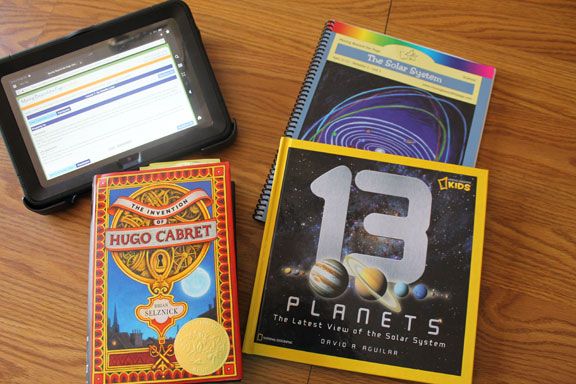
In the online version guide, you may choose to have the Parent Overview turned on or off (this feature is password protected so don’t pick the dog’s name as your password). When it’s on, you’ll see notes to the parent and the answer key in gray boxes. When it’s off, questions for the student have pencil and keyboard icons. Choose the pencil and you can print out the page of questions to write on, choose the keyboard and a separate window opens for you to type in your answers (my son’s a typist). The image below compares the two views of the first lesson.
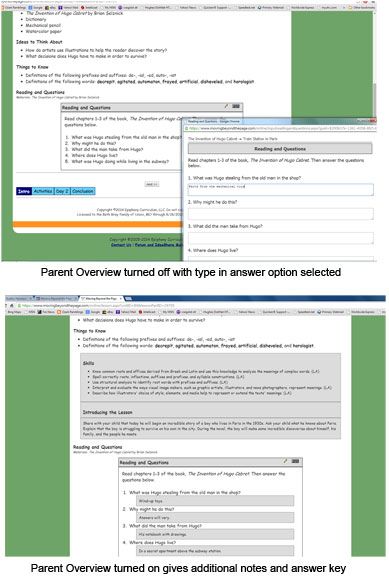
The Solar System
Ages 11-13, $33.94 ($29.88 online version)
Now onto the individual units. My son wanted to start with The Solar System, so we will too. In addition to the physical copy of the 153 page curriculum guide we received a hardback copy of 13 Planets:The Latest View of the Solar System (60 pp.) written by David A. Aguilar. This book is written from a big bang/billions of years/the Moon forming from pieces of the Earth perspective You’re probably familiar with 9 of the planets (Pluto is classified as a dwarf planet), but this might be the first time you’ve heard mention of 4 other dwarf planets: Ceres, Haumea, Makemake, and Eris.
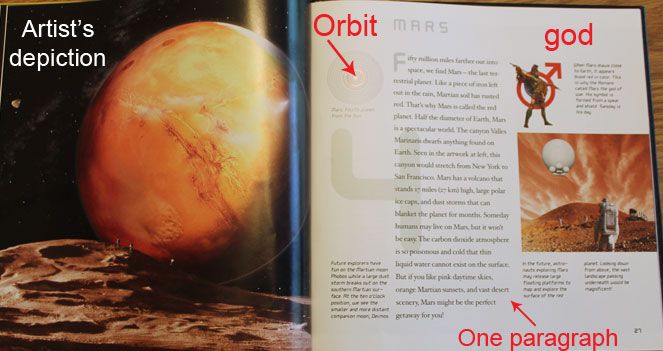
For each planet, the is a full page photograph or artist’s conception, a drawing of the god or goddess it’s named after, a diagram of it’s orbit around the sun, but really just a short paragraph with a few facts about the planet itself. Often, this wasn’t enough information to fill in the charts for the student’s activity and we’d have to look at other resources from our o home library. Younger (or less enthusiastic) students may opt to write the answers for the board game questions on the back of the cards—most only require one word or number (larger/smaller, length of a year, etc.). There were also three “Ideas to Think About” in each lesson—I suppose this is what they consider the critical thinking part of the lesson, but there was no direction how to use the questions other than read them. The entire unit has nine lessons and is designed to be covered in 15 days according to their syllabus.
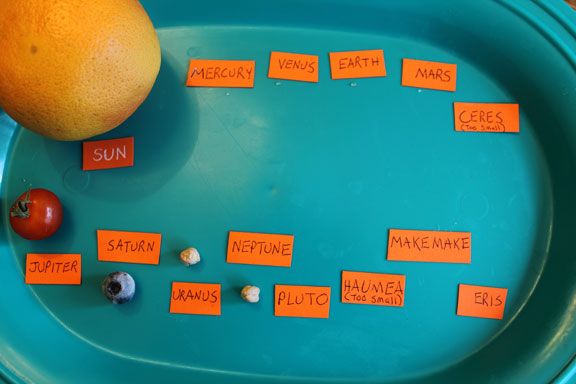
Our final project was a grocery bag solar system. We gathered and labeled our planet models but didn’t actually space them out according to scale – it really wouldn’t be realistic to place grains of sugar and salt hundreds of yards apart and be able to see anything. The guide also mention a Styrofoam ball solar system kit that comes with the full year curriculum but I could not find it sold as a separate item on the Moving Beyond the Page website. It shouldn’t be too hard to find a similar model at the local craft store. Other activities involved typing in a web address for the Moving Beyond the Page website, but then we’d be forwarded on to an outside site like NASA. At least one of these links was out of date and we got a 404 Error message.
The Invention of Hugo Cabret
Ages 9-11, $39.98 ($35.92 online version)
 For The Invention of Hugo Cabret, we had the online version of the guide but were sent the hardback version of the novel by Brian Selznick. Rather than look on the computer every day, I stuck Post-it notes to divide the book into each day’s reading assignment. If you’re not familiar with this novel, a great deal of the story is told simply with pictures. In fact, you may find a span of 20 or more pages of only illustrations. For this reason, my son didn’t mind “reading” three chapters a day nearly 10 days in a row (and sometimes the activities would involve more reading, like two versions of Anderson’s The Little Mermaid). Still I wonder if that pace could be maintained by a 9-11 year old in a normal book? Of course if you purchase the study as a stand alone unit you can set your own schedule, but as a full year curriculum, the student is expected to work through five science, five social studies, and five language arts units per semester.
For The Invention of Hugo Cabret, we had the online version of the guide but were sent the hardback version of the novel by Brian Selznick. Rather than look on the computer every day, I stuck Post-it notes to divide the book into each day’s reading assignment. If you’re not familiar with this novel, a great deal of the story is told simply with pictures. In fact, you may find a span of 20 or more pages of only illustrations. For this reason, my son didn’t mind “reading” three chapters a day nearly 10 days in a row (and sometimes the activities would involve more reading, like two versions of Anderson’s The Little Mermaid). Still I wonder if that pace could be maintained by a 9-11 year old in a normal book? Of course if you purchase the study as a stand alone unit you can set your own schedule, but as a full year curriculum, the student is expected to work through five science, five social studies, and five language arts units per semester.
For each of the seven lessons there are comprehension questions to answer and vocabulary to learn (words, suffixes and prefixes). Sometimes there are printables for writing assignments and sometimes the student is expected to write in a journal they’ve been keeping. Among the PDF files for getting ready is a Guide to Writing and Grammar, but other than that I found no formal instruction. I assume that might be in a different language art unit of the complete curriculum.
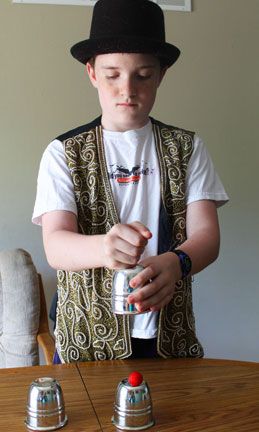 It wasn’t all study, reading and writing. For the second lesson my Schnickelfritz got to practice some magic (one of the key characters in the book used to be a magician). One trick involved optical illusion, one manipulating cards, and one based on math. Fritz already has a fair number of magic tricks under his belt so he put on quite a show.
It wasn’t all study, reading and writing. For the second lesson my Schnickelfritz got to practice some magic (one of the key characters in the book used to be a magician). One trick involved optical illusion, one manipulating cards, and one based on math. Fritz already has a fair number of magic tricks under his belt so he put on quite a show.
We did not complete every activity for every lesson. In lesson Six, is was much easier for Fritz to draw a picture of a dream (I’m not sure it was even a sleeping dream, but perhaps a day dream) then to analyze the purpose of each character and each member of the family. I have to admit even I struggled with the word “purpose.” We left it as a discussion about “roles” and “responsibilities” and I did not make him write anything down.
Bottom line: would we use Moving Beyond the Page Units again? If there was a particular novel with a guide, perhaps, although it seems expensive for a 2-3 week study. For the science units, I felt there was a lot of work summarizing facts, no experiments and very little critical thinking. This goes against the standard they had written in the front of their catalog. For this age group I think they need to be doing more lab work and work with the scientific method rather than painting models.



2 comments:
I appreciate your honest review. From what I've been seeing every literature unit is unique and every science unit as well. Ours was chock FULL of experiments and "thinking" and research. I always liked the book Hugo...I can't wait to share it with my son when he's older.
Thanks Lisa, I should say there was research. We had to look up facts about each planet and go to linked sites to learn about spacecraft and space technology. Your weather experiments look great, so I guess it just depends on the individual unit.
Post a Comment